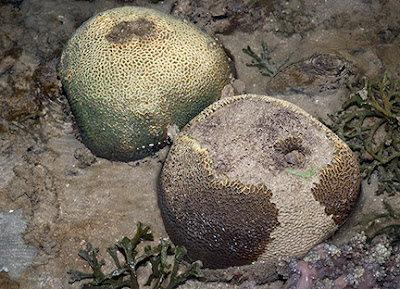In our usual health check, we encounter some bleaching, and the Brain corals look particularly unwell. Sadly, our field drone died today.
Magnificent anemones can reproduce by cloning. That is why we often see clusters of many of these anemones together and all in the cluster have the same coloured body column. Some can be bright purple as the clump above, or rose red as the clump below. I searched but couldn't find any clown anemonefishes in them. We saw a similar explosion of Magnificent anemones on Terumbu Semakau in Jun 2015 that lies opposite this shore.
Here's a little video clip of the Magnificent anemones today.
I saw one Bubble tip anemone. It wasn't bleaching but I couldn't find any clown anemonefish in it.
I saw several Giant carpet anemones. Only one had clown anemonefishes. I also saw a few Haddon's carpet anemones on the high shore.
I also check for coral bleaching during our survey. What is coral bleaching and why this is of concern on the Bleach Watch Singapore blog. Fortunately, the latest Bleaching Alert Areas from the NOAA website shows that Singapore now falls outside the 'Watch' status. Today, I didn't see any outright bleaching. Let's hope our corals have passed the danger period for the year.

There are patches of live Branching montipora coral on the higher shores, and also some clumps of Cauliflower coral. I did not see any that were bleaching.
As usual, the most abundant hard coral on the shore are Favid corals. Most of them seemed alright, although many had pale or yellowish portions. And some had portions that clearly died recently.
There were several Pore corals with this typical greyish flaky whitish portions. I thought it might be signs of the coral being eaten by the coral nudibranch that we first saw at Chek Jawa a few weeks ago. But we looked and couldn't find any nudibranchs.
I saw many Brain corals today. A few of them were alright.
But most of those I saw were very yellow and/or pale.
I saw a few colonies of Anemone corals with scum on them, although most that I saw were alright. I saw only one colony of Torch anchor coral and it was rather pale. I saw two Galaxy corals which looked alright. But I didn't see some of the special corals that I saw in Oct 2011. I also didn't come across the Xenia soft corals.
Today, I saw many more coral colonies than on Semakau South yesterday. I saw a few colonies that were outright bleaching, a few with bleaching patches. I saw only one Flowery disk coral and it was very yellow.
There were many Asparagus flowery soft corals. Some were pale yellow (left most) others were more purple and yet others were darker pink.
I was a little alarmed to see a few small patches of bleaching zoanthids. Much of the ground remained crumbly rubble and abundantly covered with Feathery soft corals and Zoanthids. Most of these looked alright. I also saw some Cerianthids on the high shore.
A few of the Leathery soft corals I saw had fine hairy things growing on them. But most of those I saw seemed alright.
There were many clumps of Yellow prickly branching sponge that were also covered in a fine hairy growth. I didn't see much seagrass today. A few clumps of Tape seagrass, most cropped short althoug there were some with longer leaf blades. All were heavily covered in epiphytes.
Other interesting finds include a Burrowing giant clam by Kok Sheng.
Sadly, our trusty drone died today as the battery failed and it made an auto landing into the water. Thanks to Heng Pei Yan the Drone Commander, the drone lasted longer than we expected and had a long full live documenting many shores and adventures. Check them out on the SG Sea Drone facebook page.
Pulau Semakau is NOT the same as the Semakau Landfill. The Landfill was created by destroying all of Pulau Saking, and about half of the original Pulau Semakau by building a very long seawall. Fortunately, the landfill was constructed and is managed in such a way that the original mangroves, seagrass meadows and reefs on Pulau Semakau were allowed to remain. It is NOT true that the construction of the Landfill created the marine life found on Pulau Semakau. The marine life was there long before the Landfill was built.
As the existing half of the Landfill was used up, the Phase 2 of the Landfill was just recently launched. This involved closing the gap of the seawall on the Semakau Landfill, forming one big pool where incinerated ash will be dumped. NEA worked to limit the damage to natural shores during the construction work for this expansion of the landfill.
The eastern shore of Pulau Semakau is right next to the seawall of the Semakau Landfill, opposite the petrochemical plants on Pulau Bukom. On the high shore are mangroves and across it is Terumbu Semakau. Here is a video clip of the eastern shore of Pulau Semakau.
The 2030 Landuse Plan by the Ministry of National Development released in Jan 2013 shows plans for 'possible future reclamation' (in light blue surrounded by dotted lines) that may impact the eastern shore of Pulau Semakau. More about the possible impact of the 2030 Landuse Plan on our shores.
 |
| Click on image for larger view. |
 |
| Click on image for larger view. |
Posts by others on this trip
- Loh Kok Sheng on facebook.
- Heng Pei Yan on facebook.
- Neo Mei Lin on her blog.
- Toh Chay Hoon on facebook.


















